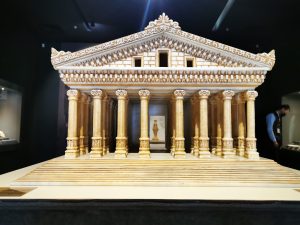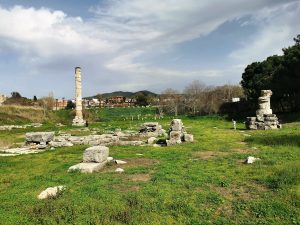The Temple of Artemis in Ephesus

Model of the Temple at Ephesus Museum in Selcuk
The massive Temple of Artemis or the Artemision was one of the Seven Wonders of the Ancient World and the most important sanctuary of Ephesus. None of the temples for the Roman gods in the city could ever become that popular among Ephesians.
Since 10th century BC there were cult practices in this area. The first temple from the mid 7th century BC, although a very simple construction, counts among the oldest of the Greek temples with surrounding colonnades.
In about 570 BC started a construction of the first massive temple, surrounded by double colonnades was bulit of marble. It was about 60m wide, more than 100 m long, with about 106 columns which were funded by the Lydian King Croesus. According to tradition, the Archaic Temple fell victim to a fire in 356 B.C. set by a madman named Herostratus.

The ruins of the Temple of Artemis
The construction of a new building begun shortly afterwards; it had all the elements of the previous temple, but was slightly bigger, with about 127 columns of 18.40 m height. In late antiquity, the Temple of Artemis was converted and probably used as a church for some time, until it was completely abandoned and forgotten…
In 1869 the ruins of the temple were discovered by John Turtle Wood. Today, some of the temple remains are exhbited in the British Museum in London. Visitors who come to see the the temple ruins can’t see much, as there is only one surviving column there, as a witness of the grandeur of the original temple…
So, what’s the secret of Artemis’ popularity in Ephesus?

The statue of Artemis
Artemis was the ancient Goddess of the fertality and hunting. Her reign in this region and some other parts of the Roman Empire actually started around 1000 BC, but Ephesus was the center of the worship. We can say that the worship of Artemis was present in almost every aspect of life in that society, all the way to banking and commerce. The temple was used as a bank because no one would ever dare to steal from a holy place. People, especially rich ones, would leave their money in the sanctuary that would receive the interest for keeping it.
There were various festivals dedicated to Artemis in the city. Some of them would usually, after a certain point, become drunken orgies and exhibition of sexual immorality. Such a strong pagan cult in this kind of environment was a big problem for the early church. Every year, on the 6th May, Ephesians were celebrating spring and the birthday of Artemis. During this festival, the main street of Ephesus - also called sacred way, was filled with massive processions of thousands of people holding Artemis’ symbols and figurines. Dancing, singing and cheering, they would walk all the way down to the harbour where the statue of Artemis would be dipped into the water to restore her virginity.

zodiac symbols
There are some very well preserved examples of Artemis statues. She is usually represented in a typical archaic static pose. Lower part of her body is covered by a long robe with reliefs of various animals, which represent Artemis' title of Lady of the Animals. One of Artemis' characteristics is that she protects fertility, which may be symbolized by the spherical objects that cover the lower part of her chest. General idea is that they are female breasts, but according to some other interpretations, they probably represent the testicles of a bull. On the upper part of her chest, she wears a zodiac, a symbol that first appeared in Babylonia. There are slight differences between some examples of Artemis statues. Some have a mural crown, a Mesopotamian and Syrian motif that became popular in the Hellenistic age, and other examples are adorned with a high-pillared headdress.
When we look back at the history of this region, it seems that a certain female cult has always existed. Starting with the goddess Kybele, to Artemis and Diana, and later the Virgin Mary – it seems that this part of Asia Minor has traditionally had a deep respect for goddesses representing fertility. Today, the only detail that follows this tradition is a stork nest on the top of the single remaining column of the Temple of Artemis.
